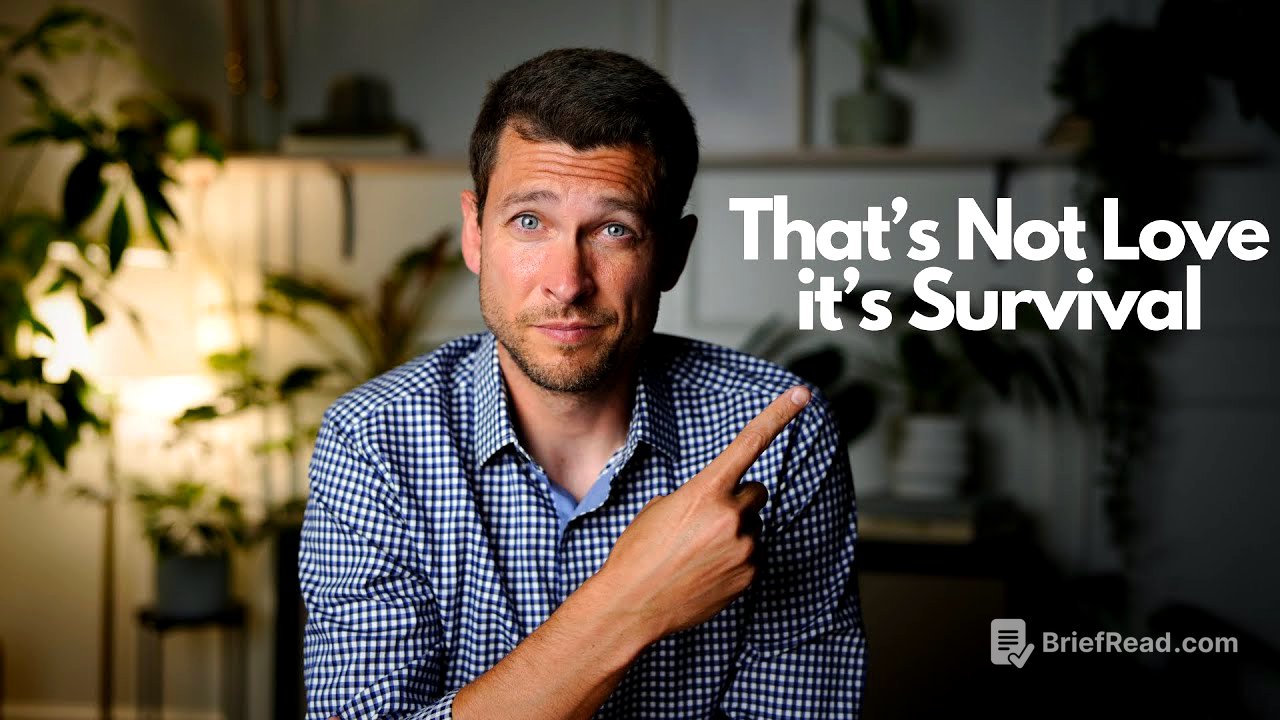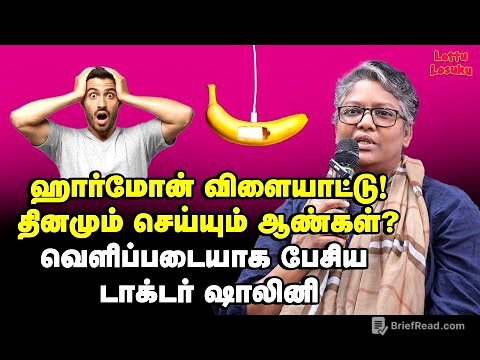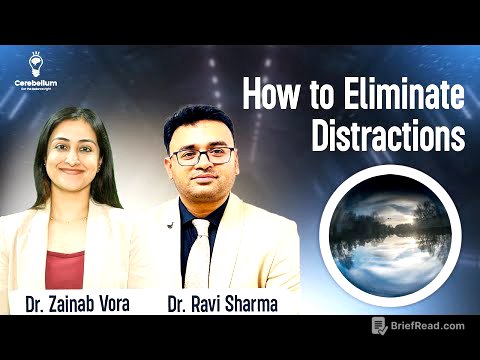TLDR;
This video talks about trauma bonds, which are unhealthy attachments in toxic or abusive relationships. It highlights the cycle of abuse followed by positive reinforcement, making it difficult to leave. The video emphasizes recognizing signs like feeling addicted to the partner, taking all responsibility, fearing honesty, and seeing the partner as both the cause and potential cure for pain. It encourages self-compassion, setting boundaries, and seeking professional help to break free from these destructive patterns and prioritize one's own well-being.
- Trauma bonds involve a cycle of abuse and love bombing.
- Key signs include feeling unable to leave, taking all responsibility, and fearing honesty.
- Healing involves self-compassion, setting boundaries, and seeking professional help.
Introduction: Understanding Toxic Relationships and Trauma Bonds [0:00]
The speaker starts by sharing her past experience of being in a toxic relationship, where she didn't recognize the red flags and lacked the green flags necessary for a healthy relationship. She highlights how being constantly labeled as the problem can lead to self-doubt and silence. The speaker questions whether the other person is equally invested in making the relationship work and willing to do the necessary self-reflection and communication. She stresses that self-improvement alone cannot fix someone else's issues and that staying in such relationships can erode self-trust. The video aims to help viewers understand these patterns, offering compassion while also encouraging them to recognize what they deserve in a relationship and differentiate between love and a trauma bond. She advises seeking professional help and prioritizing safety by leaving abusive situations.
What is a Trauma Bond? [2:27]
A trauma bond is described as an intense, unhealthy attachment in a dysfunctional, toxic, or abusive relationship. This bond often forms when one partner is manipulative, controlling, or abusive, and the other feels trapped due to emotional dependency, fear of abandonment, or a misplaced sense of loyalty. The speaker clarifies that a trauma bond isn't just a shared history of trauma, but a cycle of intermittent abuse followed by positive reinforcement like love bombing, attention, and affection. This cycle makes it difficult to leave, as the abuse is infrequent enough to maintain confusion and hope. The speaker emphasizes that staying in such relationships isn't about victim blaming, but often stems from a lack of understanding of what healthy love should look and feel like, possibly due to chaotic or abusive childhood experiences.
Sign 5: Feeling Impossible to Leave [5:21]
The fifth sign of a trauma bond is feeling unable to leave the relationship, even though staying is emotionally damaging. The speaker shares her personal experience of feeling addicted to her partner, with extreme highs and lows that trained her brain to wait for the next high. She warns against mistaking the make-up periods after terrible fights as bonding, clarifying that it's actually chaos and survival, not genuine connection or love. She cautions against being manipulated into believing that these fights make the relationship stronger, emphasizing that enduring abuse doesn't equate to a healthy bond. The speaker highlights that abusive people often exploit their partner's unwillingness to hurt them, using it against them. She realized she was trying to provide unconditional love and acceptance, but her partner wasn't a safe recipient, often rejecting and misusing it.
Sign 4: The Double Standard [9:29]
The fourth sign of a trauma bond is the presence of a double standard, where you would never treat your partner the way they treat you. The speaker asks the viewer to imagine treating their partner with the same disrespect, interruption, or dismissiveness they receive, highlighting the unequal power dynamic in the relationship. She emphasizes that feeling safe and loved requires equality and mutual respect, which are absent in trauma-bonded relationships. The speaker directly addresses the viewer, affirming their worthiness of real love, safety, and consideration. She stresses that emotional abuse, even when subtle, aims at manipulation and control, eroding self-esteem through gaslighting, blame, invalidation, and belittlement. The speaker lists examples of emotionally abusive phrases, emphasizing that consistent use of such language without repair constitutes abuse.
Sign 3: Taking All the Responsibility [13:17]
The third sign is taking all the responsibility in the relationship, often cleaning up after the partner to prevent them from appearing as the "bad person." This involves minimizing or justifying their actions due to shame or a desire to avoid difficult explanations. The speaker notes that individuals in such relationships often become experts in managing their partner's triggers and emotions, walking on eggshells to maintain peace. This behavior, mistaken for love and consideration, is actually enabling and involves doing the emotional labor for both partners. The speaker shares her past experience of feeling needed, but acknowledges that this dynamic leads to exhaustion and resentment. She emphasizes that it's not one's job to teach someone else how to be a mature adult and that trying to understand or excuse their behavior, even by diagnosing them with narcissism or attributing it to their past, is ultimately unproductive.
Sign 2: Afraid to Be Honest [17:38]
The second sign of a trauma bond is being afraid to be honest and set boundaries, often due to the partner's manipulation and portrayal of you as selfish. The speaker emphasizes that relationships cannot thrive without honesty and that constantly operating from a place of fear is detrimental to one's well-being, leading to anxiety, anger, and sleep issues. Suppressing feelings and needs to keep the peace ultimately leads to resentment and explosive outbursts, which toxic individuals then use against you. The speaker reassures the viewer that they deserve someone who encourages honesty, authenticity, and open communication without judgment, and who is willing to work through issues together as a team. She acknowledges the shame that can arise from recognizing these patterns and encourages self-compassion for attempting to break free from deeply ingrained wounds.
Sign 1: Seeing Them as the Cause and the Cure [20:04]
The primary sign of a trauma bond is viewing the partner as both the cause of pain and the potential source of healing. This is because individuals in trauma bonds often try to recreate the initial stages of the relationship, even if those stages were based on manipulation and love bombing. The speaker stresses the importance of being selective about who you give your love to and avoiding the trap of seeking external validation from someone who is not capable of providing it. She explains that the desire to fix or be with the other person, even at the expense of one's own needs, stems from a belief that one must be of service to be loved and valuable. The speaker encourages viewers to recognize that leaving unhealthy relationships is not a waste of time and to confront their fears of being alone or making a mistake.
Conclusion: Prioritizing Safety and Self-Love [23:39]
In closing, the speaker encourages viewers to prioritize their safety and well-being by asking themselves if they feel safe, honest, and valued in their relationship. She emphasizes the importance of understanding and validating one's own needs and feelings, and of recognizing that these are essential for a healthy relationship. The speaker acknowledges the difficulty of breaking generational cycles of trauma and encourages self-compassion and accountability. She recommends seeking professional help and reminds viewers that they are not broken or a failure, but simply learning how to escape survival mode. The speaker concludes by stressing that healing often requires removing oneself from the source of pain and that this, while difficult, is necessary.









